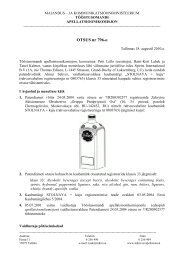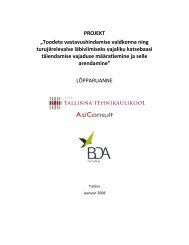Feasibility study for an Estonian Materials Technology Programme
Feasibility study for an Estonian Materials Technology Programme
Feasibility study for an Estonian Materials Technology Programme
Create successful ePaper yourself
Turn your PDF publications into a flip-book with our unique Google optimized e-Paper software.
50<br />
<strong>Feasibility</strong> <strong>study</strong> <strong>for</strong> <strong>an</strong> Estoni<strong>an</strong> <strong>Materials</strong> <strong>Technology</strong> <strong>Programme</strong><br />
2. <strong>Materials</strong> technology in Estonia<br />
However, some interesting spearheads c<strong>an</strong> be found in the industry including the collaboration between<br />
the Estoni<strong>an</strong> N<strong>an</strong>otechnology Competence Centre <strong>an</strong>d Haine Paelavabrik as well as Toom Tekstiil <strong>an</strong>d<br />
Esfil Tehno producing non-woven textiles. There is also potential support available from the researchers of<br />
fundamental physics <strong>an</strong>d chemistry in the country.<br />
Implications <strong>for</strong> the industry <strong>for</strong> materials technology adaptation <strong>an</strong>d development:<br />
The industry is currently very much focused on clothing <strong>an</strong>d home textiles, which are sectors with little<br />
growth in the future<br />
The size of Estoni<strong>an</strong> textiles industry me<strong>an</strong>s that there would be potential in adopting more value<br />
added technologies<br />
There is currently little research <strong>an</strong>d development work done at universities but especially comp<strong>an</strong>ies<br />
Collaboration between comp<strong>an</strong>ies <strong>an</strong>d universities should be heavily increased to tr<strong>an</strong>sfer adv<strong>an</strong>ced<br />
technologies <strong>an</strong>d educated work<strong>for</strong>ce to the industry<br />
Future development of the national industry should start with key stakeholders in the area<br />
TUT (Textile technology), TKTK (textile technology), ENCC, Esfil Tehno, Toom Tekstiil, other large textiles<br />
comp<strong>an</strong>ies<br />
Case: Esfil Techno<br />
Background<br />
ESFIL TEHNO AS is a m<strong>an</strong>ufacturing comp<strong>an</strong>y established in 1964 in Sillamäe, the northeastern part of<br />
Estonia. The comp<strong>an</strong>y employs currently approxiametely 80 employees, of which 10 are in head office <strong>an</strong>d the<br />
rest work production. The comp<strong>an</strong>y has 10 production lines which each require 8 people working in 3 shifts,<br />
<strong>an</strong>d were already in use during the Soviet times. Exceptional in Estonia, the comp<strong>an</strong>y has put up a production<br />
pl<strong>an</strong>t based on the technology it has developed itself.<br />
Esfil Techno develops <strong>an</strong>d produces by electrospinning highly efficient non-woven polymer filtering materials<br />
made of micro <strong>an</strong>d n<strong>an</strong>o fibres. These materials are used in their product which include<br />
Products-respirators<br />
Analytical tapes <strong>for</strong> radiation<br />
Water Filters <strong>an</strong>d separation materials <strong>for</strong> battaries<br />
Air filtration<br />
Historically, their most sold products have been respirators <strong>for</strong> nuclear power pl<strong>an</strong>ts, as they were the main<br />
producer in the Soviet Union. Still the biggest customers are in Russia <strong>an</strong>d <strong>for</strong>mer Soviet countries. Five years<br />
ago the comp<strong>an</strong>y decided to exp<strong>an</strong>d to the Europe<strong>an</strong> market. Largest competition includes comp<strong>an</strong>ies like<br />
Ahlström. Current success factor relies on the technology developed in-house <strong>an</strong>d the experience of mass<br />
production of ultrathin fibers. The materials <strong>an</strong>d technology of the products are patented in national <strong>an</strong>d<br />
Europe<strong>an</strong> patent boards.<br />
<strong>Technology</strong> relies on electrospinning. Electrospinning is a method <strong>for</strong> preparation of ultrathin fibers, used<br />
<strong>for</strong> e.g. textiles to produce seamless non-woven garments by integrating adv<strong>an</strong>ced m<strong>an</strong>ufacturing with fibre<br />
electrospinning. This would introduce multi-functionality including flame, chemical, environmental protection.<br />
The challenge is in difficulties of h<strong>an</strong>dling the barely visible fibres. Medicine is <strong>an</strong>other very interesting application<br />
area including e.g. tissue engineering <strong>an</strong>d drug delivery. Currently the technology has mostly only been<br />
applied on the laboratory scale.<br />
R&D & University-Comp<strong>an</strong>y collaboration<br />
Esfil Techno is actively looking <strong>for</strong> new partners <strong>an</strong>d ideas where to use their technology. Esfil Techno claims<br />
to have the only mass-scale production pl<strong>an</strong>t of electrospinning in Europe <strong>an</strong>d is thus currently seen as <strong>an</strong><br />
interesting partner <strong>for</strong> Europe<strong>an</strong> projects. They are a partner in two researches <strong>for</strong> SMEs projects:<br />
New concept <strong>an</strong>d technology <strong>for</strong> high energy rock fall protection fences<br />
Ambulatory magneto-enh<strong>an</strong>cement of tr<strong>an</strong>sdermal high yield silver therapy





